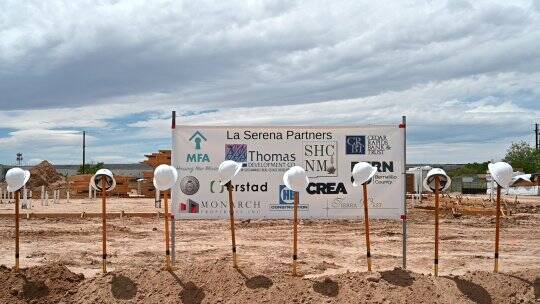The very diverse state of New Mexico faces a long list of challenges, but as wages remain stagnant and home prices soar, many residents of the Land of Enchantment feel that the goal of home ownership is too far out of reach.
According to the 2024 New Mexico Housing Needs Assessment conducted by the New Mexico Mortgage Finance Authority, more than 40% of New Mexican households make less than $50,000 annually, making the population more susceptible to being unhoused. This has created a need for more affordable housing in the state as more and more people are being priced out of the market every day.

While poverty is a clear and significant factor in the housing crisis in New Mexico, there are very complex underlying variables that have led to this problem as well. A prominent reason for the high rate of homelessness is the state’s large rural population, who have limited access to resources like shelters, treatment centers and housing in general. The population of people who need help is very widespread, and offering options to address their needs can be logistically challenging.
Another disparity in New Mexico’s population, highlighted in the assessment, is its high percentage of older citizens. More than 30% of New Mexican households include someone age 65 or older, compared to the national average of just 11.5%.
This stark difference in demographics, compared to the rest of the U.S., makes New Mexico’s crisis much harder to combat because of the already dwindling market that comes with age. Many older Americans cannot afford a home at all, let alone one that is accessible and suited for their ever-changing needs.
Because of the narrowing ability of the government to provide support, many in need are looking toward community led organizations like the Supportive Housing Coalition of New Mexico, a nonprofit organization based in Albuquerque. Interim CEO Debbie Davis said that many older people are already constrained financially, making it difficult to stay afloat.
“A good majority of seniors are on fixed incomes,” Davis said. “They are getting social security or disability, maybe both.”
Older people who are nearing retirement require extra security in the housing market to ensure their well-being. They also often are not consistently progressing through different economic brackets as younger people are, which is why Davis said we need to accommodate low-income seniors.
“Folks with the lowest incomes are the hardest hit,” Davis said. “Where they might have been able to rent from one kind of housing to another kind of housing and then eventually to a house. That’s not happening.”
The housing crisis has left hundreds of older New Mexicans struggling with the difficult choice between basic necessities and keeping a roof over their heads.
“If the fair market rent for a two-bedroom unit is over $1,000 and they get $1,200 a month, then they don’t have anything to live on,” Davis said.
The problem is also seen in the state’s high number of multigenerational homes, as older New Mexicans are forced to squeeze in with their families because it is too expensive to live on their own.
Chas Laila Tso, the tribal initiatives manager at the SHC, said this is common in the more isolated parts of the state.
“We do see it a lot in tribal communities, especially the Gallup area,” she said.
This growing need for resources has caused an influx of people from rural communities into New Mexican cities in search of more direct benefits, which is a situation Tso said hits close to home.
“My grandparents actually moved from the reservation to Albuquerque just for employment and for health reasons” she said. “With that, other family members came out, and just with hardships from tribal lands, it was more accessible here.”
Albuquerque has observed the “graying” of its inhabitants as, according to a 2021 study done by the Human Services Department of New Mexico, with people over the age of 65 making up more than 40% of the population in Bernalillo County, the most populous county in the state.
This has prompted action by city legislature and the SHC. Ground has been broken on the La Serena Apartments, an affordable housing complex designated for Duke City residents who have entered their golden years. Rents will be based on tenants’ income levels rather than based on market value, protecting unhoused seniors who are struggling.
Other municipalities across the state are planning similar projects. Construction began last month on a new affordable housing complex in Las Cruces, paving the way for even more New Mexican families to get the much needed help they deserve.
Although more effort is being put toward accessible housing in general, Davis said the homes being built are not catering to the larger population that is struggling the most.
“Now they are building more multifamily properties than they have for a long time, but they are not all affordable,” Davis said.